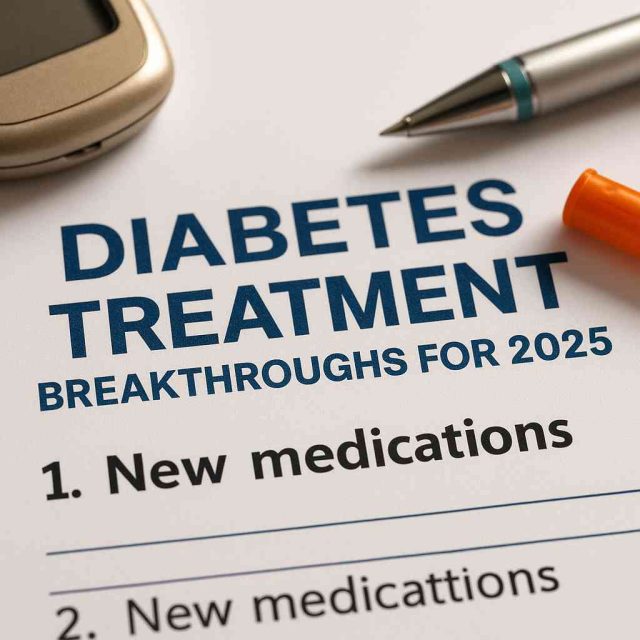Type 2 diabetes management continues to evolve, and 2025 promises new hope for millions. With pharmaceutical innovations, digital health integrations, and groundbreaking clinical findings, the landscape of diabetes treatment is rapidly shifting. But which developments truly stand out?
Table of Contents
- Personalized GLP-1 Agonists
- Dual-Acting GIP/GLP-1 Therapies
- Continuous Glucose Monitoring Advancements
- Digital Therapeutics and AI-Driven Apps
- Beta Cell Regeneration Research
- Microbiome-Based Interventions
- Cardio-Renal Diabetes Therapies
Personalized GLP-1 Agonists
GLP-1 receptor agonists have transformed diabetes care by improving glycemic control and promoting weight loss. In 2025, pharmaceutical companies are focusing on personalized formulations of these therapies, tailoring dosing schedules and molecular structures to individual metabolic profiles.
These developments aim to reduce gastrointestinal side effects and increase adherence. Drugs like semaglutide (Ozempic) are being reformulated with extended-release versions and alternate delivery methods, such as microneedle patches and oral capsules. This innovation enhances bioavailability and minimizes injection fatigue.
Personalized GLP-1s represent a significant leap in diabetes treatment, targeting glucose management more efficiently while aligning with patients’ unique needs.
Dual-Acting GIP/GLP-1 Therapies
Tirzepatide (Mounjaro), a dual GIP/GLP-1 receptor agonist, has garnered significant attention since its FDA approval. In 2025, research has pushed further, optimizing this class for broader metabolic benefits.
These dual-action drugs not only improve insulin sensitivity but also curb appetite and support cardiovascular health. Trials suggest that combination therapies reduce A1C levels more effectively than monotherapies.
Moreover, newer versions are being tested for long-term weight management in patients with obesity and type 2 diabetes. These medications are bridging the gap between diabetes and obesity care, further enhancing their impact.
Continuous Glucose Monitoring Advancements
CGMs have revolutionized how patients and clinicians monitor blood glucose. In 2025, CGM devices are smaller, more accurate, and fully integrated with wearable tech.
Next-generation CGMs provide real-time glucose insights via smartwatches, notify users of trends, and suggest insulin dosing changes. Devices like Dexcom G7 and Abbott FreeStyle Libre 3 offer 14-day sensors with faster warm-up times and more intuitive mobile apps.
Incorporating CGM data into electronic health records (EHR) helps providers detect patterns and adjust therapy in real-time. This evolution reinforces the central role of technology in modern diabetes treatment.
Explore current CGM discussions at the Diabetes in Control article archive.
Digital Therapeutics and AI-Driven Apps
Behavioral interventions are critical to managing type 2 diabetes. However, scaling these interventions has long been a challenge. Enter digital therapeutics.
In 2025, AI-powered mobile apps like Virta Health and Omada Health deliver personalized coaching, meal planning, and physical activity prompts. These platforms harness machine learning to adapt to user data and provide real-time feedback.
Additionally, digital therapeutics are increasingly reimbursed by insurance, signaling a shift toward mainstream acceptance. Their integration with glucose meters and fitness trackers offers a cohesive care experience.
For a holistic approach, patients can also consult online professionals at Healthcare.pro.
Beta Cell Regeneration Research
Regenerating pancreatic beta cells could redefine type 2 diabetes care. Though early in development, regenerative therapies using stem cells and small molecules are gaining traction.
In 2025, multiple biotech firms have entered phase II clinical trials exploring the use of agents that stimulate beta cell replication. Some candidates aim to halt beta cell apoptosis, thus preserving insulin production capacity in early-stage patients.
If successful, these therapies could shift diabetes from a chronic managed condition to one with the potential for partial remission.
Microbiome-Based Interventions
The gut microbiome’s role in glucose metabolism is a hotbed of research. New findings suggest that modifying gut flora composition can improve insulin sensitivity and inflammatory responses.
In 2025, companies are developing microbiome-based capsules containing live bacteria designed to restore metabolic balance. Early trials show promise in reducing fasting glucose and inflammatory markers.
These interventions offer a non-pharmacological complement to standard diabetes treatment. Additionally, they may be especially useful in patients with gastrointestinal comorbidities.
Cardio-Renal Diabetes Therapies
Heart disease and kidney complications remain leading causes of morbidity in type 2 diabetes. Recognizing this, pharmaceutical companies are developing dual-purpose medications.
SGLT2 inhibitors like empagliflozin (Jardiance) and dapagliflozin (Farxiga) continue to demonstrate cardiovascular and renal benefits. In 2025, newer SGLT2s and dual-acting drugs combine glycemic control with organ protection.
Moreover, these medications are now integrated into treatment guidelines as first-line therapy in patients with coexisting heart failure or CKD.
Conclusion
The future of diabetes treatment is bright. As we navigate 2025, patients and providers benefit from a wider array of tools that extend beyond glycemic control. From personalized medications and digital therapeutics to regenerative and microbiome-focused therapies, the diabetes landscape is more patient-centered and outcome-driven than ever before.
Ultimately, these breakthroughs underscore a shift toward integrated care—one that addresses not just blood sugar, but the broader health ecosystem of the person living with diabetes.
For more updates and insights, visit the Diabetes in Control article section.
FAQs
What is the biggest breakthrough in diabetes treatment for 2025?
Dual GIP/GLP-1 therapies and advanced CGMs are among the most impactful innovations this year.
Can beta cell regeneration cure type 2 diabetes?
While not a cure yet, beta cell regeneration research is progressing and may allow partial remission in the future.
Are digital therapeutics effective for diabetes care?
Yes, they provide real-time support and have shown improved outcomes in adherence and behavior change.
What role does the gut microbiome play in diabetes?
A healthy microbiome can enhance insulin sensitivity and reduce inflammation, complementing traditional therapies.
Do these treatments replace insulin?
Not all. Some therapies may reduce insulin need, especially in early-stage type 2 diabetes, but insulin remains vital for some patients.
Disclaimer
“This content is not medical advice. For any health issues, always consult a healthcare professional. In an emergency, call 911 or your local emergency services.”
